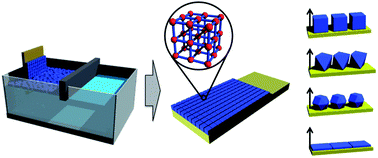Porous coordination polymers (PCPs), with their ordered nanoporous systems and large surface areas, are very attractive for numerous applications that involve controlled molecular transport properties. To fully exploit their potential, a straightforward processing method to deposit the PCP crystals on various substrates and to create freestanding membranes with a controlled pore orientation is highly desirable. Here, we report a strategy to self-assemble PCP crystals into two-dimensional monolayers using Langmuir–Blodgettry. This approach allows the deposition on various substrates over several square centimeters, uniformly and with controllable density of the crystals. In addition we show that by controlling the morphology of the crystalline building blocks we can program their orientation on the substrates. Using a copper grid as the substrate, these assemblies can also be fabricated as freestanding sheets. This approach represents a very simple and scalable processing method to translate the orientation of the channel network from the individual crystal to the macroscopic scale, and can help to incorporate this interesting class of materials within advanced hierarchical systems.

You have access to this article
 Please wait while we load your content...
Something went wrong. Try again?
Please wait while we load your content...
Something went wrong. Try again?


 Please wait while we load your content...
Please wait while we load your content...